Modeling Internal Flow Patterns of Sessile Droplets on Horizontally Vibrating Substrates
Abstract
1. Introduction
2. Mathematical Model
2.1. Physical Description and Assumptions
- (1)
- The flow inside the droplet is incompressible and non-axisymmetric under the horizontal vibration, and the contact line of the droplet remains pinned.
- (2)
- Since the oscillation period of droplets is much smaller than the evaporation time of droplets, evaporation is not considered during vibrations.
- (3)
- The radius of the droplet is less than the capillary length of the droplet (, about 2.73 mm for water, where is the acceleration of gravity, is the surface tension, and is the density of the liquid), the influence of gravity on the shape of the droplet is negligible compared to the surface tension, and the droplets on the substrate are assumed to be spherical caps.
2.2. VOF-CSF Model
2.3. Dynamic Contact Angle Model
2.4. Boundary Conditions
3. Results and Discussion
3.1. Model Validation
3.2. The Evolution of Droplet Oscillation Modes
3.3. Internal Flow Patterns Inside Oscillating Droplets
3.4. Variations in Contact Angle of the Droplet during Vibrations
3.5. Variations in Average Velocity within the Droplet during Vibrations
4. Conclusions
Author Contributions
Funding
Data Availability Statement
Conflicts of Interest
Nomenclature
| amplitude, | substrate velocity | ||
| capillary number | velocity vector | ||
| frequency | velocity of x direction | ||
| surface tension force | volume fraction | ||
| acceleration of gravity | contact angle | ||
| capillary length | initial contact angle | ||
| droplet mass | dynamic contact angle | ||
| order of modes | contact angles difference | ||
| outward unit normal vector | curvature of interface | ||
| unit normal vector of the substrate | viscosity | ||
| time | density | ||
| tangent vector of the substrate | surface tension | ||
| fluid-phase velocity along the x, y, z direction | resonant frequency of droplet |
References
- Sefiane, K. Patterns from drying drops. Adv. Colloid Interface Sci. 2014, 206, 372–381. [Google Scholar] [CrossRef] [PubMed]
- Mondal, R.; Lama, H.; Sahu, K.C. Physics of drying complex fluid drop: Flow field, pattern formation, and desiccation cracks. Phys. Fluids 2023, 35, 061301. [Google Scholar] [CrossRef]
- Shan, Y.G.; Wang, Y.L.; Coyle, T. Analysis of deposits formation in plasma spraying with liquid precursors. Appl. Therm. Eng. 2013, 51, 690–697. [Google Scholar] [CrossRef]
- Sandu, I.; Dumitru, M.; Fleaca, C.T.; Dumitrache, F. Hanging colloidal drop: A new photonic crystal synthesis route. Photonics Nanostruct. 2018, 29, 42–48. [Google Scholar] [CrossRef]
- Zang, D.Y.; Tarafdar, S.; Tarasevich, Y.; Choudhury, M.D.; Dutta, T. Evaporation of a droplet: From physics to applications. Phys. Rep. 2019, 804, 1–56. [Google Scholar] [CrossRef]
- Sanyal, A.; Basu, S.; Chowdhuri, S.; Kabi, P.; Chaudhuri, S. Precision control of drying using rhythmic dancing of sessile nanoparticle laden droplets. Appl. Phys. Lett. 2014, 104, 163108. [Google Scholar] [CrossRef]
- Sanyal, A.; Basu, S. Evolution of internal flows in mechanically oscillating sessile droplets undergoing evaporation. Chem. Eng. Sci. 2017, 163, 179–188. [Google Scholar] [CrossRef]
- Kabi, P.; Razdan, V.; Roy, D.; Bansal, L.; Sahoo, S.; Mukherjee, R.; Chaudhuri, S.; Basu, S. Evaporation-induced alterations in oscillation and flow characteristics of a sessile droplet on a rose-mimetic surface. Soft Matter 2021, 17, 1487–1496. [Google Scholar] [CrossRef] [PubMed]
- Rayleigh, L. On the capillary phenomenon of Jets. Proc. R. Soc. Lond. 1879, 29, 71–97. [Google Scholar]
- Kelvin, W. Mathematical and Physical Papers; Cambridge University Press: Cambridge, UK, 1882. [Google Scholar]
- Lamb, H. Hydrodynamics; Cambridge University Press: Cambridge, UK, 1932. [Google Scholar]
- Strani, M.; Sabetta, F. Free vibrations of a drop in partial contact with a solid support. J. Fluid Mech. 1984, 141, 233–247. [Google Scholar] [CrossRef]
- Celestini, F.; Kofman, R. Vibration of submillimeter-size supported droplets. Phys. Rev. E 2006, 73, 041602. [Google Scholar] [CrossRef] [PubMed]
- Noblin, X.; Buguin, A.; Brochard-Wyart, F. Vibrated sessile drops: Transition between pinned and mobile contact line oscillations. Eur. Phys. J. E 2004, 14, 395–404. [Google Scholar] [CrossRef] [PubMed]
- Noblin, X.; Buguin, A.; Brochard-Wyart, F. Vibration of sessile drops. Eur. Phys. J. 2009, 166, 7–10. [Google Scholar] [CrossRef]
- Sanyal, A.; Basu, S.; Chaudhuri, S. Controlling particle deposit morphologies in drying nano-particle laden sessile droplets using substrate oscillations. Phys. Chem. Chem. Phys. 2016, 18, 14549–14560. [Google Scholar] [CrossRef] [PubMed]
- Kabi, P.; Chattopadhyay, B.; Bhattacharyya, S.; Chaudhuri, S.; Basu, S. Evaporation-oscillation driven assembly: Micro-tailoring the spatial ordering of particles in sessile droplets. Langmuir 2018, 34, 12642–12652. [Google Scholar] [CrossRef] [PubMed]
- Noblin, X.; Kofman, R.; Celestini, F. Ratchetlike Motion of a Shaken Drop. Phys. Rev. Lett. 2009, 102, 194504. [Google Scholar] [CrossRef] [PubMed]
- Sartori, P.; Quagliati, D.; Varagnolo, S.; Pierno, M.; Mistura, G.; Magaletti, F.; Casciola, C.M. Drop motion induced by vertical vibrations. New J. Phys. 2015, 17, 113017. [Google Scholar] [CrossRef]
- Huber, R.A.; Campbell, M.; Doughramaji, N.; Derby, M.M. Vibration-enhanced droplet motion modes: Simulations of rocking, ratcheting, ratcheting with breakup, and ejection. J. Fluids Eng. 2019, 141, 071105. [Google Scholar] [CrossRef]
- Mostafa, M.; Rahimian, M.H.; Chini, S.F. Numerical investigation of vibration-induced droplet shedding on smooth surfaces with large contact angles. Phys. Rev. E 2019, 100, 023105. [Google Scholar]
- Mostafa, M.; Rahimian, M.H.; Chini, S.F. Numerical investigation of vibration-induced droplet shedding on microstructured superhydrophobic surfaces. Phys. Rev. E 2019, 99, 063111. [Google Scholar]
- Dong, L.; Chaudhury, A.; Chaudhury, M.K. Lateral vibration of a water drop and its motion on a vibrating surface. Eur. Phys. J. E 2006, 21, 231–242. [Google Scholar] [CrossRef] [PubMed]
- Annapragada, S.R.; Murthy, J.Y.; Garimella, S.V. Prediction of droplet dynamics on an incline. Int. J. Heat Mass Tran. 2012, 55, 1466–1474. [Google Scholar] [CrossRef]
- Kim, H.; Lim, H.C. Mode pattern of internal flow in a water droplet on a vibrating hydrophobic surface. J. Phys. Chem. B 2015, 119, 6740–6746. [Google Scholar] [CrossRef] [PubMed]
- Park, C.S.; Kim, H.; Lim, H.C. Study of internal flow and evaporation characteristics inside a water droplet on a vertically vibrating hydrophobic surface. Experimental Therm. Fluid Sci. 2016, 78, 112–123. [Google Scholar] [CrossRef]
- Kang, K.H.; Lee, S.J.; Lee, C.M.; Kang, I.S. Quantitative visualization of flow inside an evaporating droplet using the ray tracing method. Meas. Sci. Technol. 2004, 15, 1104–1112. [Google Scholar] [CrossRef]
- He, B.; Duan, F. Full-field convection flow visualization in pendant droplets by tilt-angle imaging. Appl. Phys. Lett. 2013, 103, 053508. [Google Scholar] [CrossRef]
- Brackbill, J.U.; Kothe, D.B.; Zemach, C. A continuum method for modelling surface tension. J. Comput. Phys. 1992, 100, 335–354. [Google Scholar] [CrossRef]
- 30. In Ansys Fluent User’s Guide; Ansys Inc.: Canonsburg, PA, USA, 2022.
- Kistler, S.F. Hydrodynamics of Wetting in Wettability; Marcel Dekker: New York, NY, USA, 1993. [Google Scholar]
- Chernova, A.A.; Kopysov, S.P.; Tonkov, L.F. Simulation of a liquid drop on a vibrating hydrophobic surface. IOP Conf. Ser. Mater. Sci. Eng. 2016, 158, 012026. [Google Scholar] [CrossRef]
- Daniel, S.; Chaudhury, M.K.; Gennes, P. Vibration-actuated drop motion on surfaces for batch microfluidic processes. Langmuir 2005, 21, 4240–4248. [Google Scholar] [CrossRef]
- Sartori, P.; Guglielmin, E.; Ferraro, D.; Filippi, D.; Zaltron, A.; Pierno, M.; Mistura, G. Motion of Newtonian drops deposited on liquid-impregnated surfaces induced by vertical vibrations. J. Fluid Mech. 2019, 876, R4. [Google Scholar] [CrossRef]
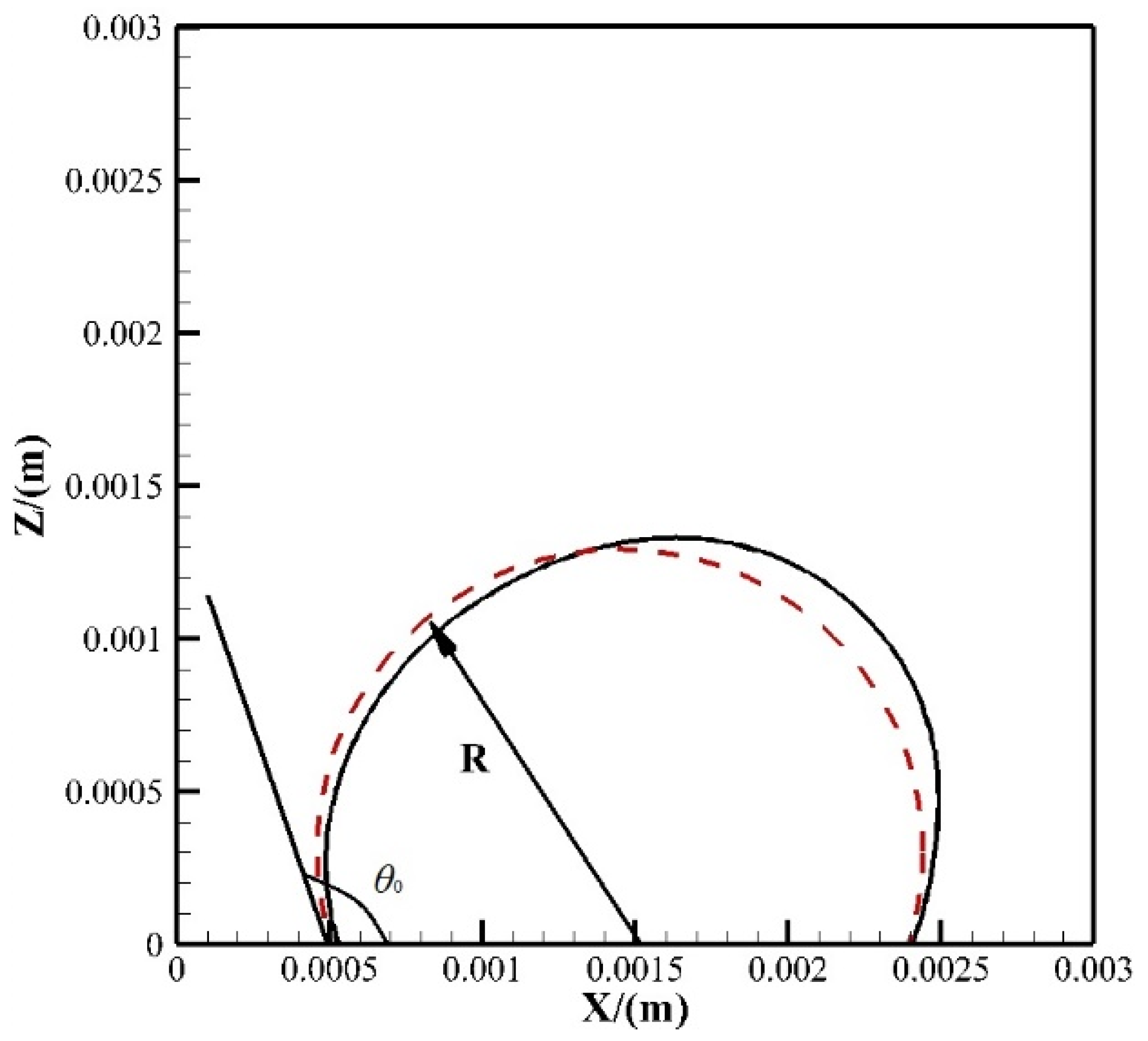

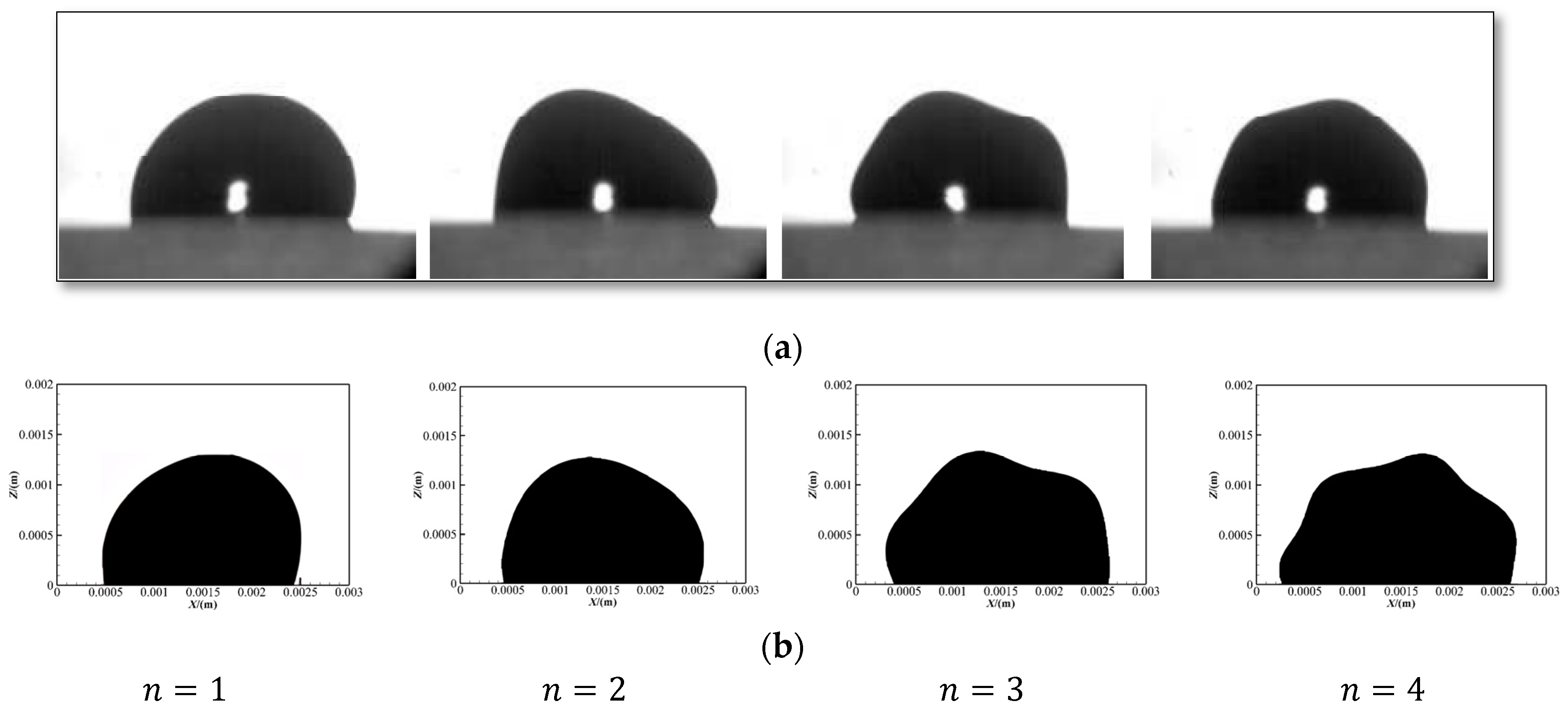
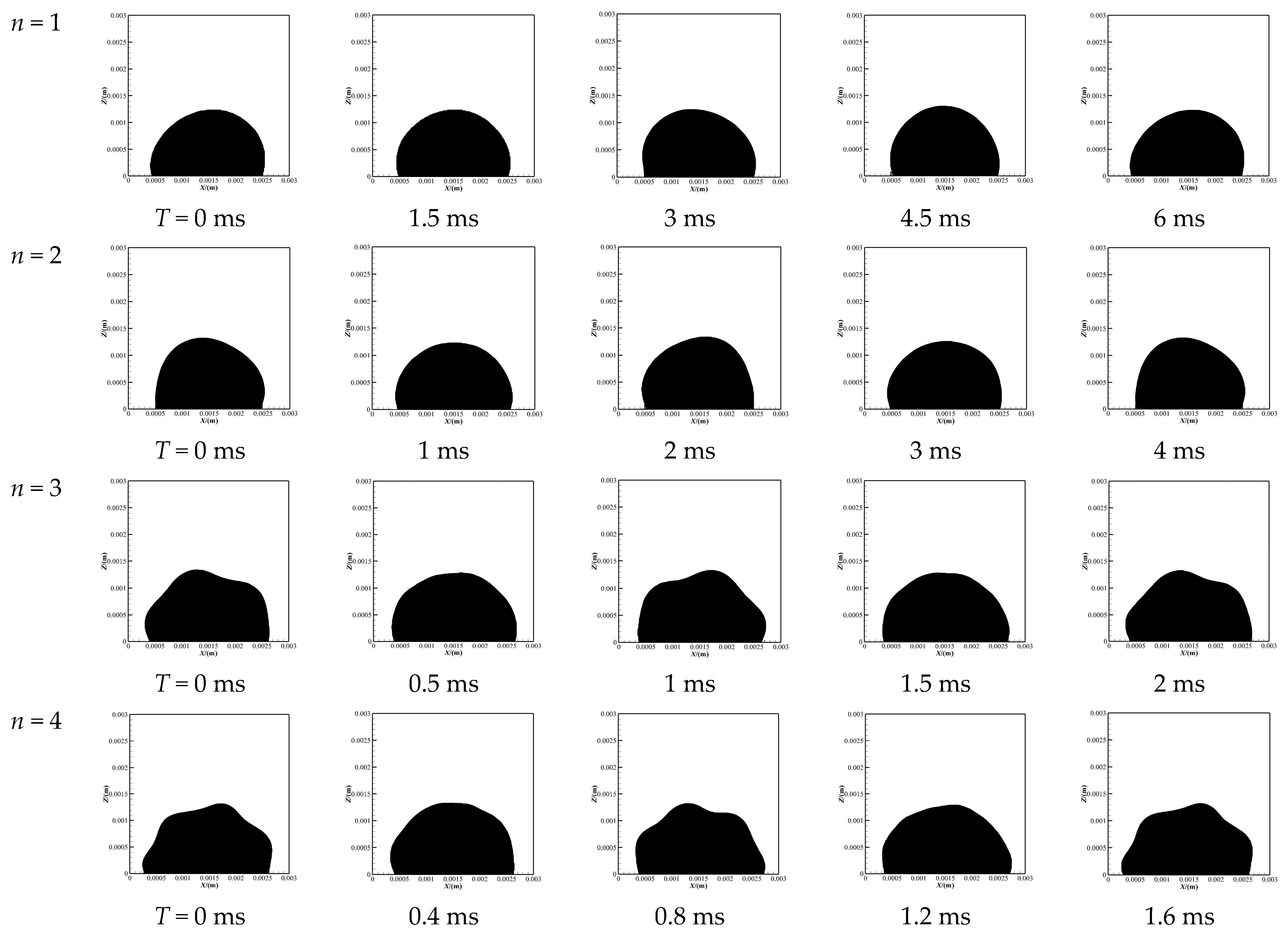
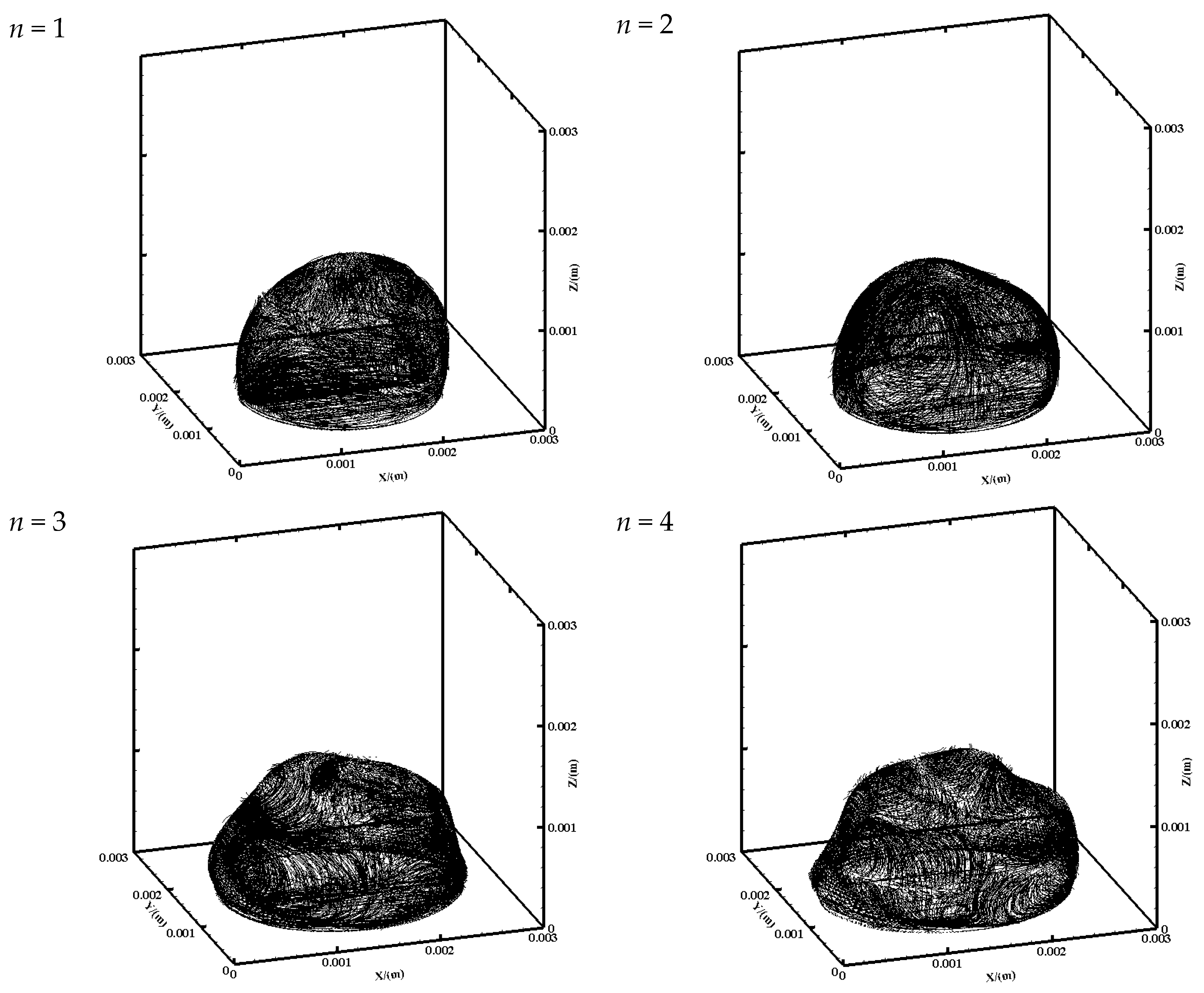
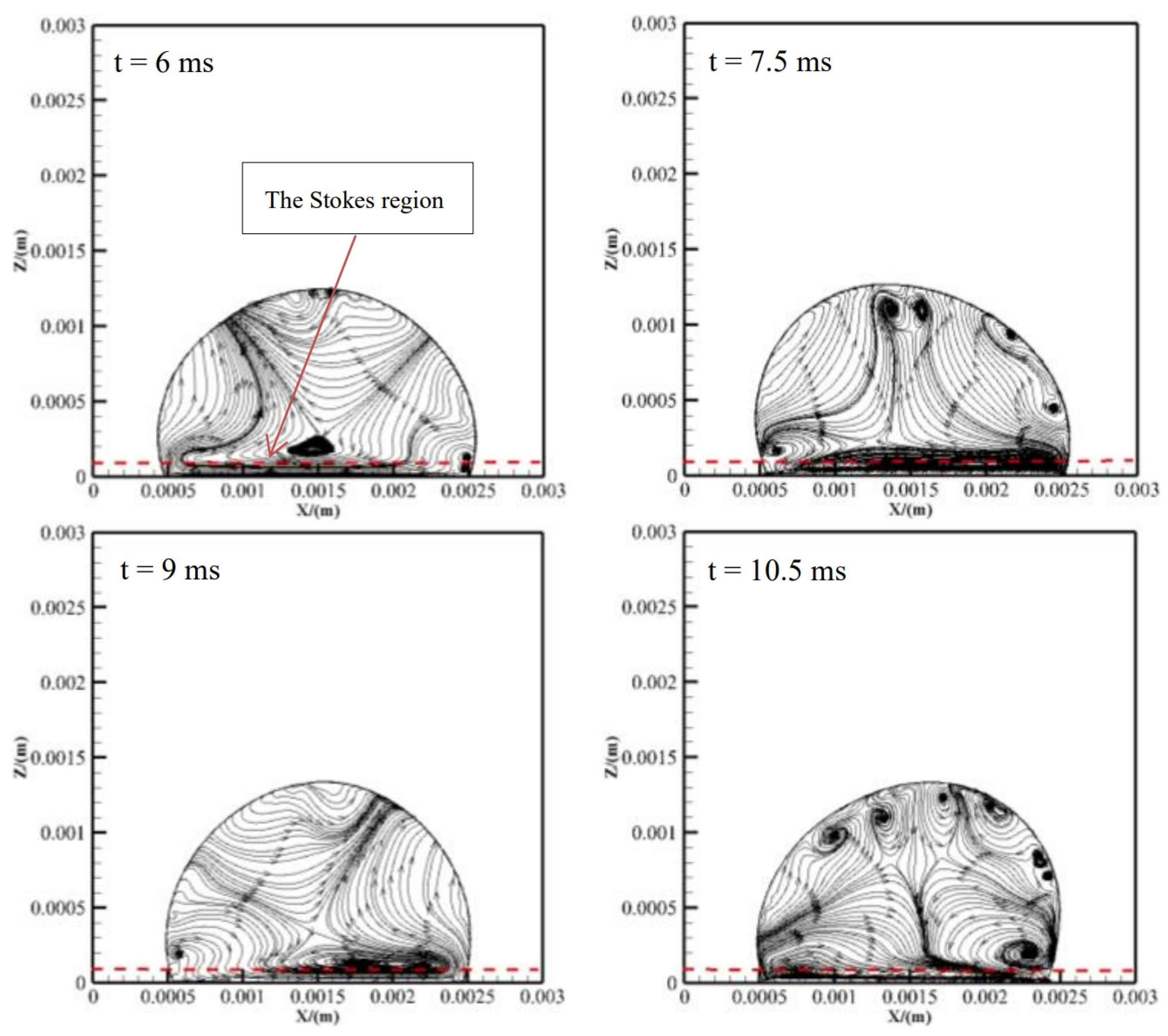
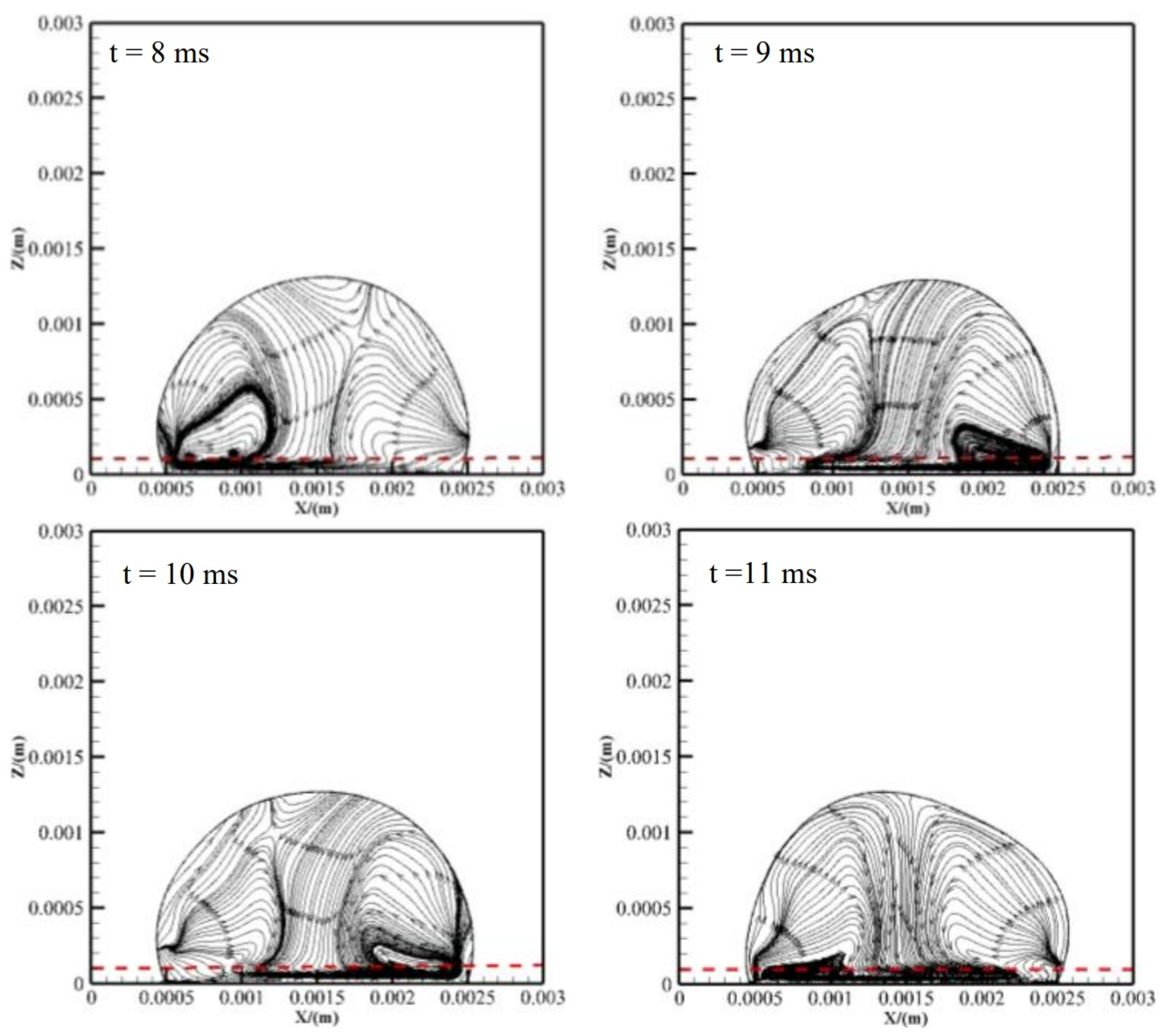
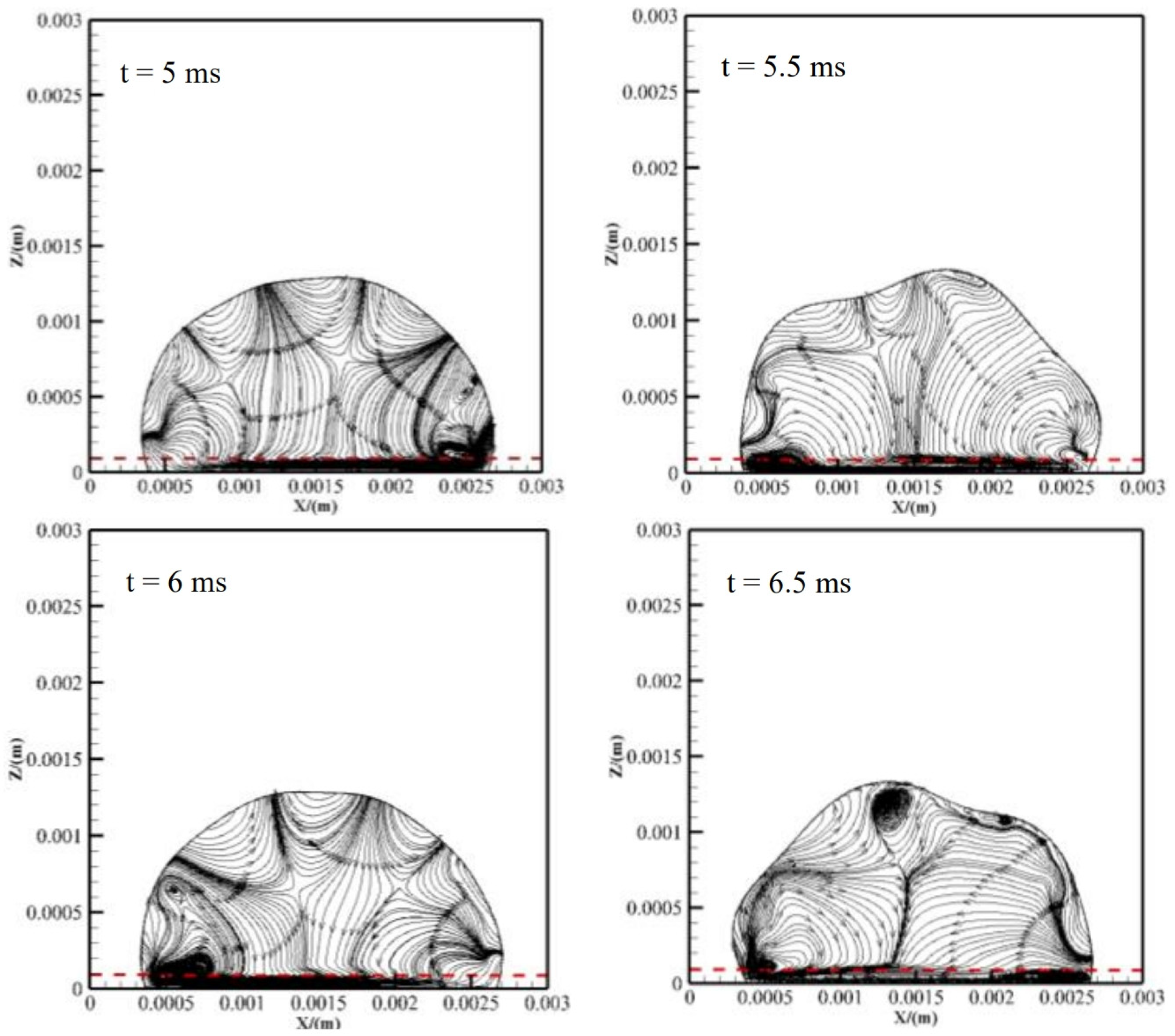
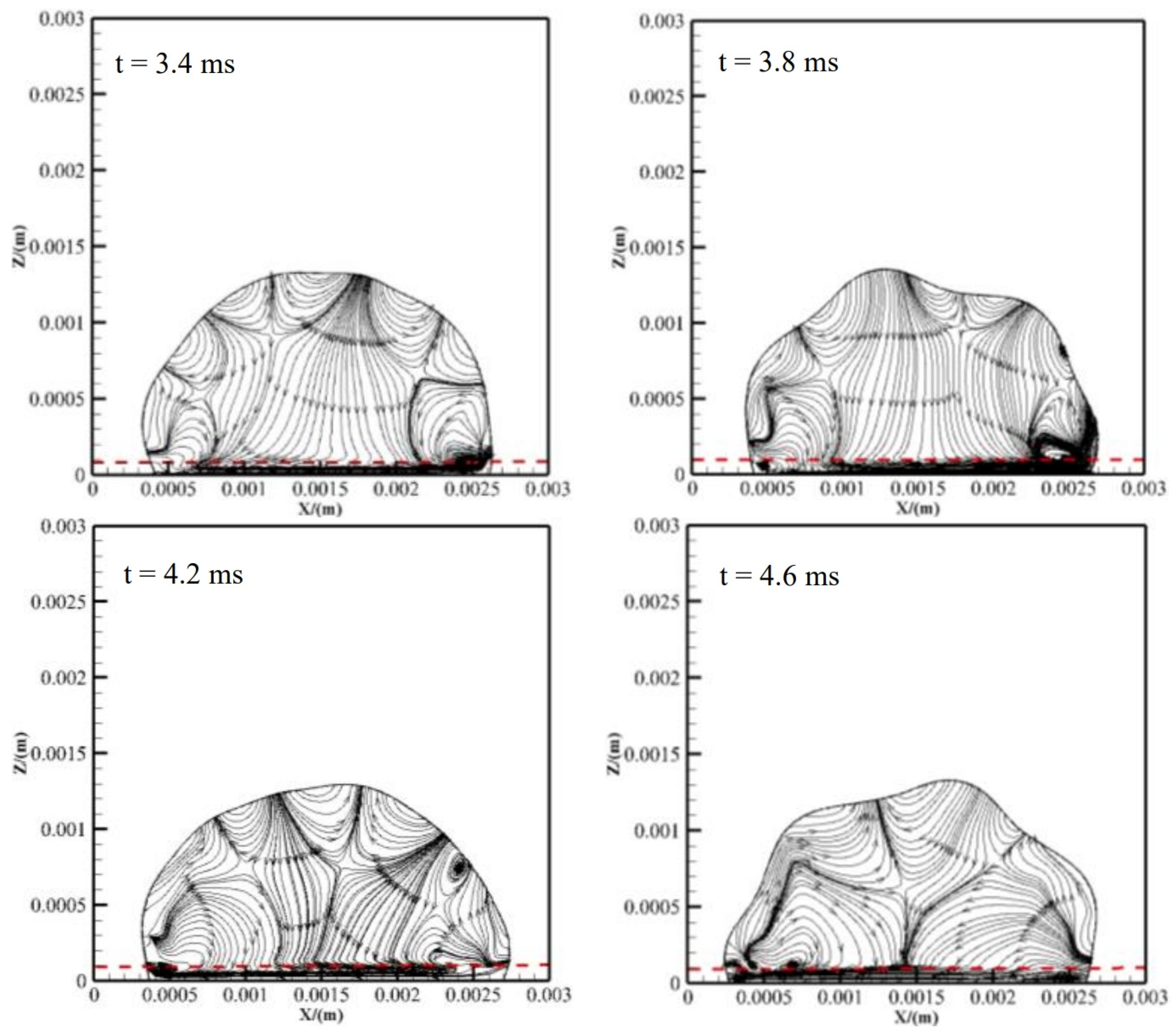
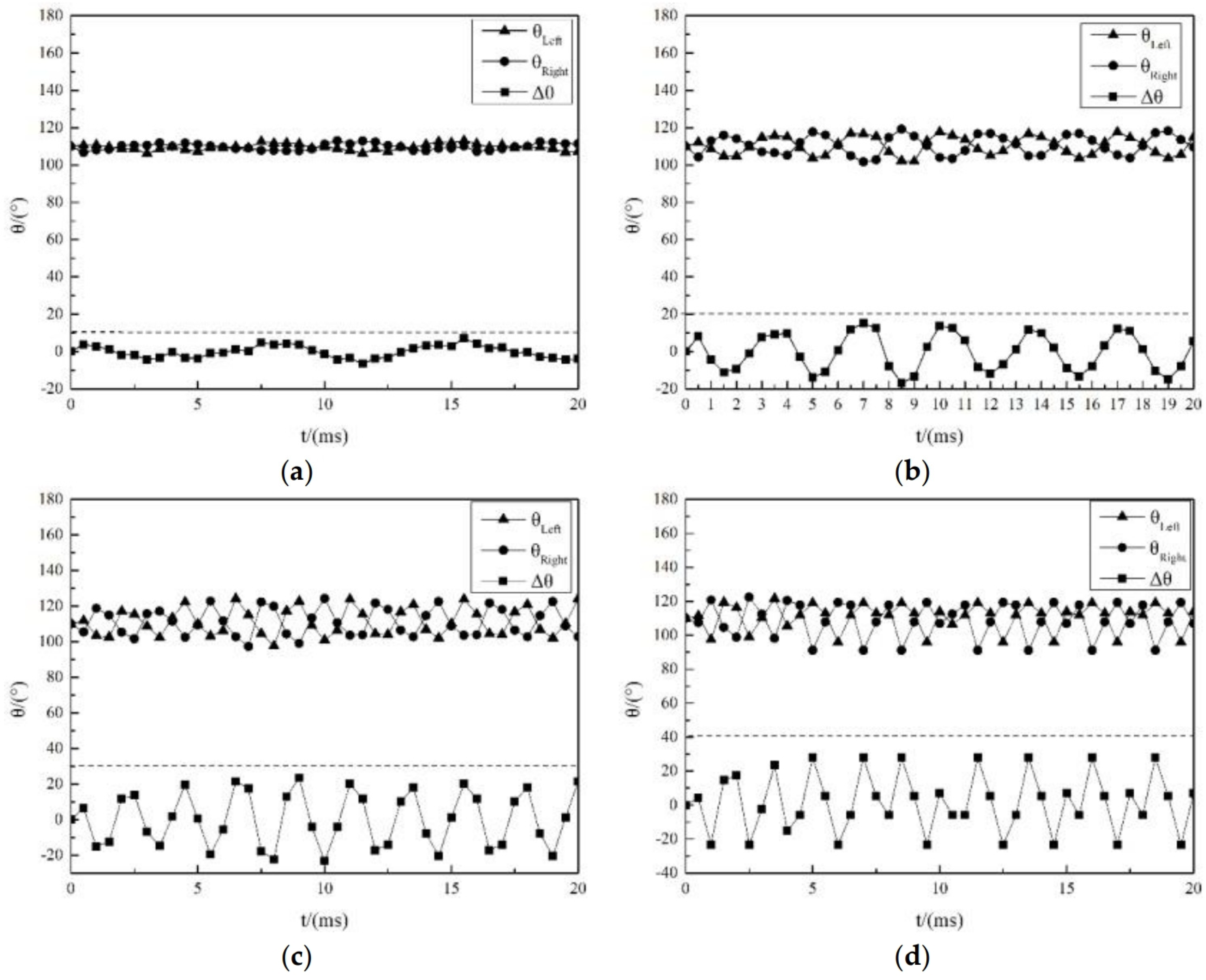
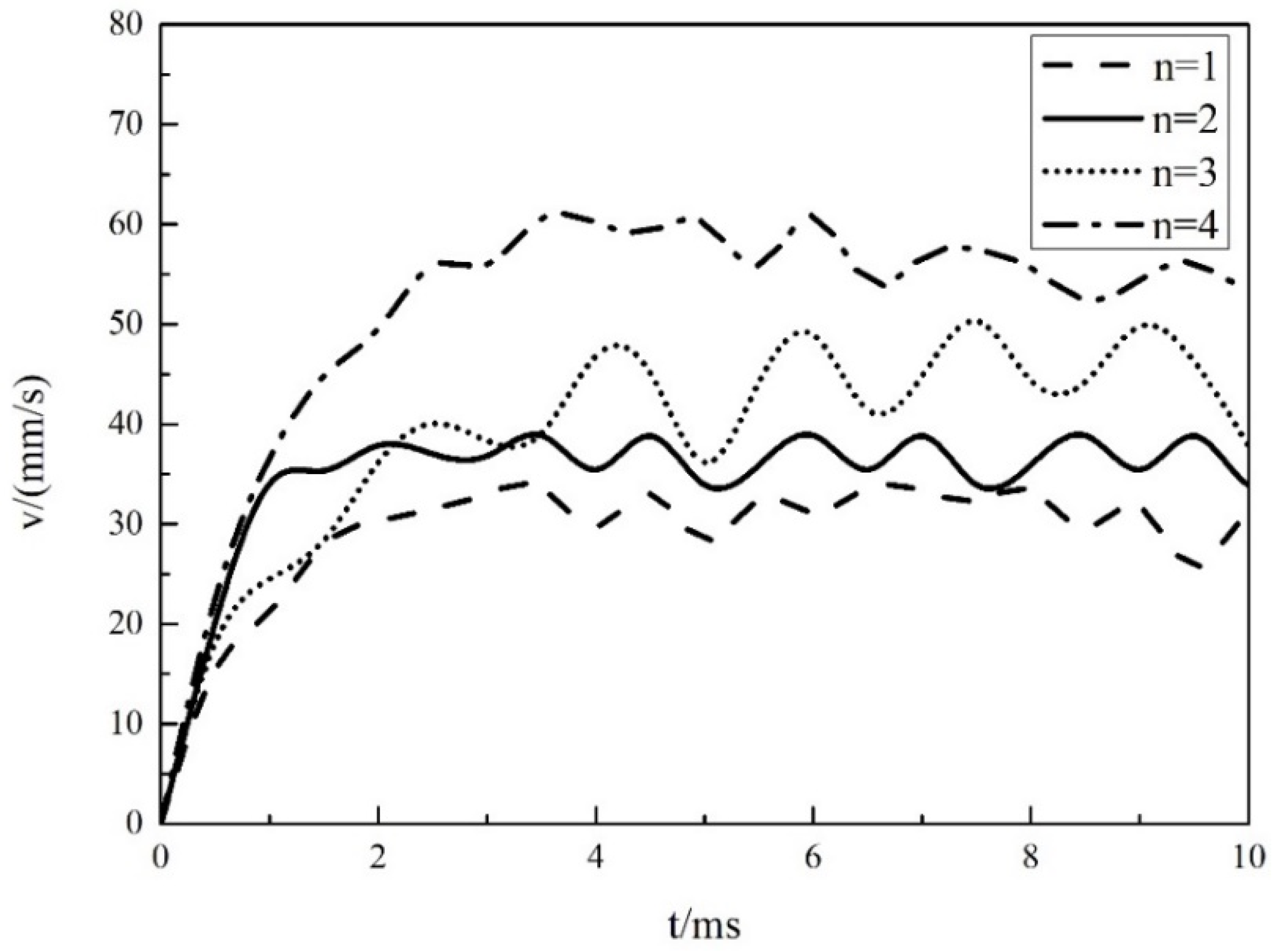
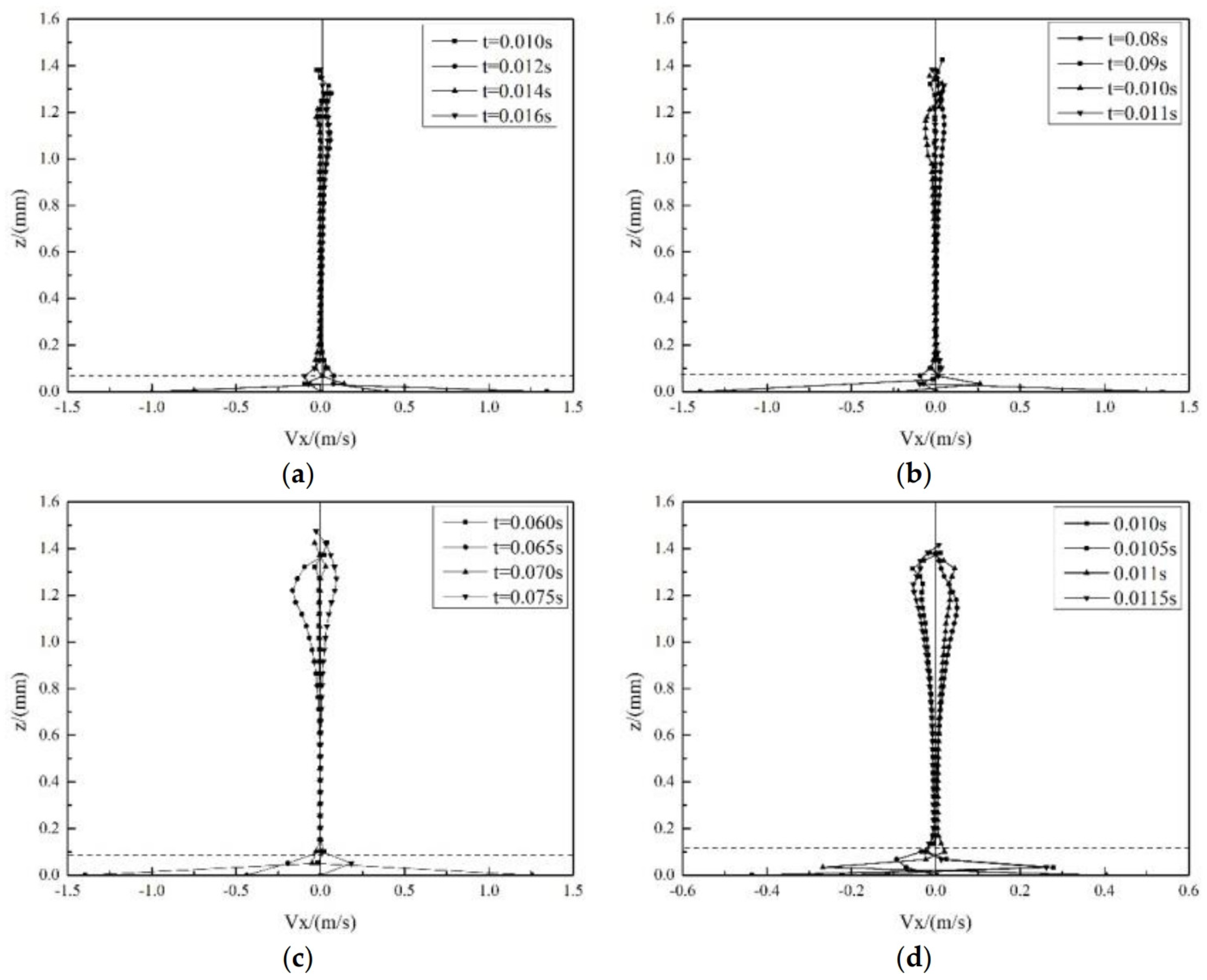
Disclaimer/Publisher’s Note: The statements, opinions and data contained in all publications are solely those of the individual author(s) and contributor(s) and not of MDPI and/or the editor(s). MDPI and/or the editor(s) disclaim responsibility for any injury to people or property resulting from any ideas, methods, instructions or products referred to in the content. |
© 2024 by the authors. Licensee MDPI, Basel, Switzerland. This article is an open access article distributed under the terms and conditions of the Creative Commons Attribution (CC BY) license (https://creativecommons.org/licenses/by/4.0/).
Share and Cite
Shan, Y.; Yin, T. Modeling Internal Flow Patterns of Sessile Droplets on Horizontally Vibrating Substrates. Processes 2024, 12, 667. https://doi.org/10.3390/pr12040667
Shan Y, Yin T. Modeling Internal Flow Patterns of Sessile Droplets on Horizontally Vibrating Substrates. Processes. 2024; 12(4):667. https://doi.org/10.3390/pr12040667
Chicago/Turabian StyleShan, Yanguang, and Tianyi Yin. 2024. "Modeling Internal Flow Patterns of Sessile Droplets on Horizontally Vibrating Substrates" Processes 12, no. 4: 667. https://doi.org/10.3390/pr12040667
APA StyleShan, Y., & Yin, T. (2024). Modeling Internal Flow Patterns of Sessile Droplets on Horizontally Vibrating Substrates. Processes, 12(4), 667. https://doi.org/10.3390/pr12040667




